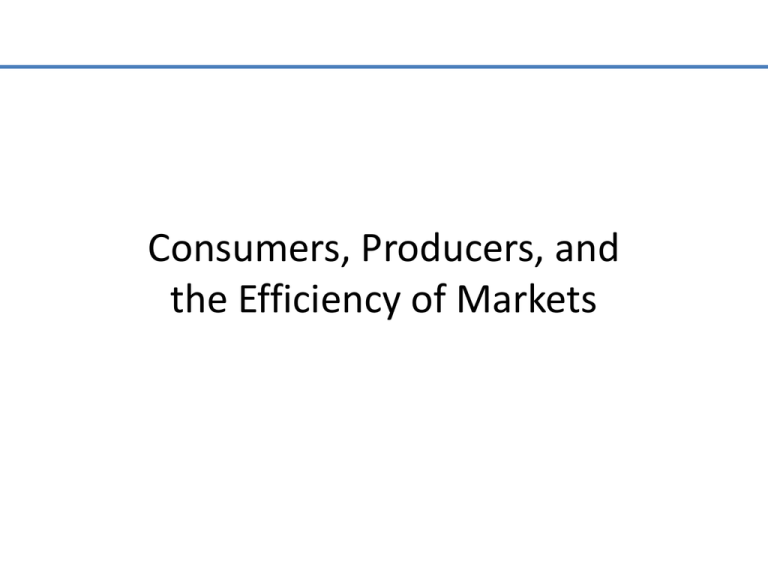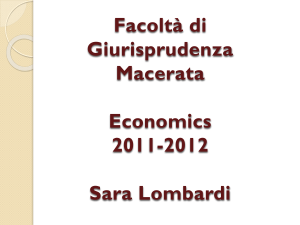
Consumers, Producers, and
the Efficiency of Markets
Consumer Surplus
• Welfare economics – how the allocation of
resources affects economic well-being
• Willingness to pay – maximum amount that a
buyer will pay for a good
• Consumer surplus – the amount a buyer is willing
to pay for a good minus amount the buyer actually
pays for it
How much are you willing to pay for the
right to drive 90 miles per hour on
Kentucky roads with a posted speed of
55 or higher?
Four possible buyers’ willingness to pay
Smartphone Example
Buyer
Ed
Randy
Cathy
Grandpa
Willingness to pay
$200
$150
$100
$50
John is willing to pay $200 for the smartphone,
Randy $150, and Sue $100
Grandpa’s willingness to pay is only $50
Measuring Market Consumer Surplus
Market Price = $100
Market Price = $175
Price
Ed’s willingness to
pay
Ed’s consumer
Surplus is $25
$200
$175
Randy’s willingness
to pay
$150
Cathy’s willingness to
pay
$100
Grandpa’s
willingness to
pay
$50
0
•
1
Ed’s Consumer
Surplus is $100
$200
2
3
4
Quantity of Phones
Randy’s Consumer
Surplus is $50
$150
Cathy’s Consumer
Surplus is $0
$100
Grandpa’s
willingness to
pay
$50
0
1
2
3
4
Quantity of Phones
To the left, only Randy purchases a phone with Consumer Surplus of $25
• To the right, Ed, Randy and Sue purchase phones with Consumer Surplus of $150
Consumer Surplus
Using the demand curve to measure consumer
surplus
– Consumer surplus is closely related to the
demand curve
– Demand schedule is derived from the
willingness to pay of the possible buyers
– At any price given by the demand curve and
willingness to pay of the marginal buyer
determines the next buyer
Consumer Surplus
The demand curve can be used to measure
consumer surplus
• Demand curve reflects buyers’ willingness to
pay
• Consumer surplus in a market is the area
below the demand curve and above the price
How the price affects consumer surplus
Consumer surplus at price P2
Consumer surplus at price P1
Price
Price
A
A
Consumer
surplus
P1
C
P1
Initial
consumer
surplus
Additional consumer
surplus to initial
consumers
C
B
B
F
P2
Demand
0
Consumer surplus
to new consumers
Q1
Quantity
D
0
Demand
E
Q1
Q2
Quantity
To the left, the price is P1, the quantity demanded is Q1, and consumer surplus equals the area of the
triangle ABC. When the price falls from P1 to P2, as in right illustration, the quantity demanded rises from Q1
to Q2, and the consumer surplus rises to the area of the triangle ADF. The increase in consumer surplus (area
BCFD) occurs in part because existing consumers now pay less (area BCED) and in part because new
consumers enter the market at the lower price (area CEF).
Consumer Surplus
How a lower price raises consumer surplus
• Buyers always want to pay less
– Initial price, P1
• Quantity demanded Q1
• Given consumer surplus
– New, lower price, P2
• Greater quantity demanded, Q2
– New buyers
• Increase in consumer surplus
– From initial buyers
– From new buyers
Consumer Surplus
Consumer surplus measures the benefit buyers
receive from a good as the buyers themselves
perceive it
– Good measure of economic well-being
– Exception: Illegal drugs
• Drug addicts
• Society’s standpoint
– Drug addicts don’t get a large benefit from being able
to buy heroin at a low price
Producer Surplus
Cost and the willingness to sell
• Cost – the value of everything a seller must give up to
produce a good
• Producer surplus – the amount a seller is paid for a
good minus the seller’s cost of providing it
The costs of four possible sellers
Example: Paving a Driveway
Seller
Bozo the banker
Ronda the corn farmer
Elroy the burger flipper
Willingness to sell
$800
$600
$300
Elroy is willing to pave the driveway for $300, Ronda
will for $600 and Bozo the banker will do it for $800
Note willingness to pave the driveway is based on
opportunities lost in Elroy’s, Ronda’s and Bozo’s current
career
Producer Surplus
Using the supply curve to measure producer
surplus
Producer surplus is closely related to the supply
curve
• Derived from the costs of the suppliers
The supply curve
Price to paving the driveway is $500
Price of
Driving
Supply
$900
Bozo’s cost
600
$500
Ronda’s cost
Elroy’s Producer Surplus of $200
$300
0
Elroy’s cost
1
2
3
4
Quantity of paved driveways
Only Elroy will pave a drive away and enjoy producer surplus of
$200. Both Ronda and Bozo have high opportunity cost in the
their current careers
The supply curve
What is price to paving the driveway is now $700
Price of
Driving
Supply
$900
$700
Bozo’s cost
Ronda’s now starts paving driveways and enjoys a
Producer Surplus of $100
600
Ronda’s cost
Elroy’s Producer Surplus is now $400
$300
0
Elroy’s cost
1
2
3
4
Quantity of paved driveways
Total market Producer Surplus is now $500
Producer Surplus
Using the supply curve to measure producer
surplus
• Supply curve reflects seller costs
• Producer surplus in a market is the area
below the price and above the supply curve
How the price affects producer surplus
(b) Producer surplus at price P2
(a) Producer surplus at price P1
Price
Price
P2
P1
B
Producer
surplus
P1
C
D
E
F
Producer surplus
to new producers
B
Initial
consumer
surplus
A
0
Supply
Additional producer
surplus to initial
producers
Supply
C
A
Q1
Quantity
0
Q1
Q2 Quantity
In panel (a), the price is P1, the quantity supplied is Q1, and producer surplus equals the area of the triangle
ABC. When the price rises from P1 to P2, as in panel (b), the quantity supplied rises from Q1 to Q2, and the
producer surplus rises to the area of the triangle ADF. The increase in producer surplus (area BCFD) occurs in
part because existing producers now receive more(area BCED) and in part because new producers enter the
market at the higher price (area CEF).
Producer Surplus
How a higher price raises producer surplus
• Sellers want to receive a higher price
– Initial price, P1
• Quantity supplied, Q1
• with a given producer surplus
– New, higher price, P2
• Greater quantity supplied, Q2
– new producers
• Increase in producer surplus
– for initial suppliers
– and for new suppliers
Market Efficiency
The benevolent social planner
– An All-knowing, all-powerful, well-intentioned
dictator
– Wants to maximize the economic well-being
of everyone in society
– Economic well-being of a society is
determined when “Total surplus” the Sum of
consumer and producer surplus is maximized
Market Efficiency
• Efficiency
– Property of a resource allocation
– Maximizing the total surplus
• Received by all members of society
• Equality
– Property of distributing economic prosperity
– Uniformly among the members of society
Market Efficiency
Evaluating the market equilibrium
Market outcomes
–Free markets allocate the supply of goods to
the buyers who value them most highly as
measured by their willingness to pay
–Free markets allocate the demand for goods to
the sellers who can produce them at the least
cost
Consumer and producer surplus in equilibrium
Price
Supply
A
D
Equilibrium
price
Consumer
surplus
E
Producer
surplus
B
Demand
C
0
Equilibrium
quantity
Quantity
Total surplus—the sum of consumer and producer surplus—
is the area between the supply and demand curves up to the
equilibrium quantity
Market Efficiency
Evaluating the market equilibrium
– Social planner
• Cannot increase economic well-being by
– Changing the allocation of consumption among buyers
– Changing the allocation of production among sellers
• Cannot rise total economic well-being by
– Increasing or decreasing the quantity of the good
– Free markets produce the quantity of goods
that maximizes the sum of consumer and
producer surplus
Market Efficiency
Evaluating the market equilibrium
–Equilibrium outcome
• Efficient allocation of resources
–The benevolent social planner
• Can leave the market outcome just as he finds it
• “Laissez faire” = “allow them to do”
Market Efficiency
Evaluating the market equilibrium
– Adam Smith’s invisible hand
• Takes all the information about buyers and sellers
into account
• Guides everyone in the market to the best
outcome
– Economic efficiency
– Free markets are the best way to organize
economic activity
Should there be a market in organs?
• Questions
– Trade a kidney for a kidney
– Trade a kidney for an expensive, experimental
cancer treatment?
– Exchange her kidney for free tuition for her son?
– Sell her kidney for cash?
• Public policy
– Illegal for people to sell their organs
– Government has imposed a price ceiling of zero
• Shortage of the good
Should there be a market in organs?
Kidney Market
“More than 70,000 Americans are waiting for kidneys, and the
list has grown by almost 5,000 per year. People are dying.”
Kidney
Price
The Organ Market
by William Saletan
Sunday, April 15, 2007
washingtonpost.com
Kidney
Supply
What are the solutions?
Kidney
Demand
Source:
20,000
45,000
Current
Supply
25,000 more live
http://www.washingtonpost.com/wpdyn/content/article/2007/04/13/AR2007041302066.html
70,000
Kidney
Quantity
Copyright © michael .roberson@eStudy.us, All rights reserved
Should there be a market in organs?
• Large benefits to allowing a free market in
organs
• Current situation
– Typical patient - wait several years for a kidney
transplant
– Every year - thousands of people die because a
kidney cannot be found
Should there be a market in organs?
Allow for kidney market
– Balance supply and demand
•
•
•
•
Sellers - extra cash in their pockets
Buyers – live
No more shortage of kidneys
Efficient allocation of resources (maximum surplus)
– Critics: worry about fairness
• Benefit the rich at the expense of the poor
• Current system: is it fair?
– Some people - extra kidney they don’t really need
– Others - dying to get one
Market Efficiency & Market Failure
Forces of supply and demand allocate
resources efficiently
– Several assumptions about how markets work
• Markets are perfectly competitive
• Outcome in a market matters only to the buyers
and sellers in that market
– When these assumptions do not hold
• our conclusion that the market equilibrium is
efficient may no longer be true
Market Efficiency & Market Failure
Competition is often far from perfect
– Market power
• A single buyer or seller (small group)
• Control market prices
• Markets are inefficient
• Keeps the price and quantity away from the
equilibrium of supply and demand
Market Efficiency & Market Failure
– Decisions of buyers and sellers may affect
people who are not participants in the market
at all
• Externalities
– Cause welfare in a market to depend on more than
just the value to the buyers and the cost to the sellers
• Inefficient equilibrium
– From the standpoint of society as a whole
Market Efficiency & Market Failure
– Market failure (market power and
externalities)
• The inability of some unregulated markets to
allocate resources efficiently
• Public policy
– Can potentially remedy the problem
– Increase economic efficiency










